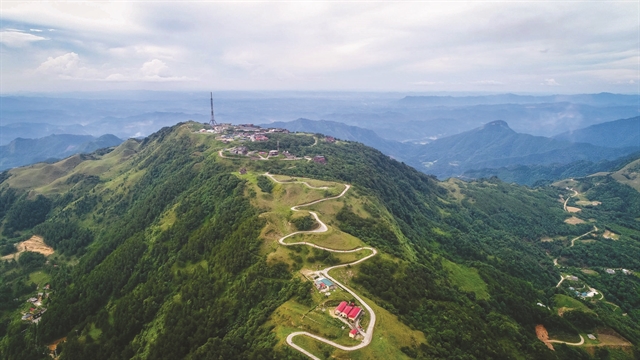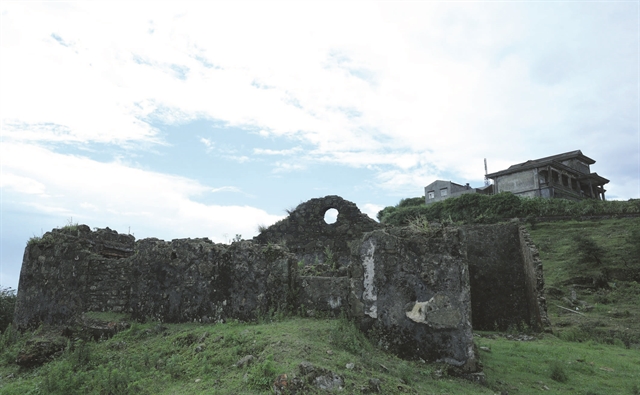Mẫu Sơn is a majestic mountain range stretching over the two districts of Cao Lộc and Lộc Bình in Lạng Sơn Province. Located about 180km from Hà Nội, Mẫu Sơn has been a popular tourist destination since the 20th century, with cool weather all year round.
It is the highest mountainous area in the northeast of Việt Nam, with an average altitude of 800-1,000 metres above sea level, made up of about 80 large and small mountains. The highest peaks are Phia Pò of Cha Mountain at 1,541 metres high and Phia Mè peak of Mẹ Mountain at about 1,520 metres high.

Mẫu Sơn is the highest mountainous area of Lạng Sơn Province. — VNA/VNS Photo Anh Tuấn
In this unspoiled mountain region, the climate is typical of subtropical and temperate regions. Summer has an average temperature of between 16 - 21 degrees Celsius. Winter is much colder and temperatures can fall to -5 degrees Celsius, though average temperatures are between 7 and 13 degrees. Fog, ice and snow are not uncommon during the colder days.

The Mẫu Sơn mountain range is often covered with fog, ice and snow during winter. — VNA/VNS Photo Anh Tuấn
Many people think that summer is the ideal season to travel to Mẫu Sơn because they can bathe in waterfalls and camp in primaeval forests with fresh and cool air. But according to the locals here, this northern mountainous region is beautiful all year round. Spring is the season of festivals, when pears, plums and peaches are in full bloom, while autumn is the season of golden terraced fields and the leaves in the forest change colour. Winter is the season for 'cloud hunting'.
'Cloud hunting' is a race against time to reach the top of the mountain before the sun has risen. At that time, the top of the mountain is covered with white clouds, making visitors feel like they have walked on clouds and arrived in a fairyland.

The top of the mountain covered with white clouds in the early morning, one of Mẫu Sơn's most well-known draws. — VNS/VNA Photo Anh Tuấn
The best time for cloud hunting is from December to March. At this time, the temperature in Mẫu Sơn is ideal for the accumulation of clouds. Not only that, the clouds in this season are very stable, so visitors can admire a beautiful scene created by thousands of clouds.
Besides the magnificent scenery, this mountainous area also has dozens of large and small streams and waterfalls in the heart of the old forest, creating a majestic picture of the poetic natural landscape. These spots include Long Đầu stream, Bay, Ngọc Bích Tiên Nữ and Ngàn Tằm waterfall.
The streams and waterfalls all originate from the Mẫu Sơn Mountain complex, flowing through the steep mountain slopes and old forests of Lặp Pịa Village, Mẫu Sơn Commune to the lower area of Long Đầu and Pác Tạng villages, Yên Khoái Commune.
Over thousands of years, the rocky beds of the streams and waterfalls have been smoothed by the rushing water. Now they are covered with green moss and have many different shapes, but all are part of the vivid, wild beauty of the area.
To admire the waterfalls in Mẫu Sơn or to immerse yourself in the cool spring waters, visitors should be in good health - it is quite a walk through the forest!

The primeval forests of Mẫu Sơn are home to hundreds of different species of plants. — VNA/VNS Photo Anh Tuấn
In the rainy season, the waterfalls are strong and fierce, but most of the time they are calmer, with clear, cool water running over the abyss.
Thanks to its fresh air and ancient forests, Mẫu Sơn creates a feeling of comfort and freedom. From the top of the mountains, visitors can enjoy the magnificent natural beauty, especially when watching the sunrise in the morning and the sunset in the evening.
Despite a natural landscape comparable to Tam Đảo, Sa Pa, Bà Nà Hills and Đà Lạt, Mẫu Sơn's tourism potential has not been fully exploited and has been likened to a 'sleeping giant' that has not been awakened yet.

Mẫu Sơn tourism has not yet been exploited to its full potential. — VNA/VNS Photo Anh Tuấn
Lạng Sơn Province is focusing on developing the area into a centre of entertainment, eco-tourism, cultural and spiritual tourism.
Based on the available strengths and potentials, the province also hopes to expand cooperation in tourism development with other provinces through attracting capital from domestic and foreign investors, contributing to building a charming image of Vietnamese tourism in the eyes of international friends. — VNS
OVietnam